Vic Gatrell
Let me begin with a few words that go rather against the fashionable grain. I seem to be the only person in Britain who doesn’t warm to Hogarth, and I guess that needs a bit of explaining. It’s all to do with my enthusiasm for comedy, and Hogarth, alas, doesn’t cater to it. Many eighteenth-century and subsequent critics applied and still apply the word ‘comic’ to Hogarth, but I think the first thing we ought to do is get rid of that word in the repertoire of Hogarth criticism –- not least because most Augustan theorists of humour used the word comedy to signify satire. Of course there’s always wit in his satire, along with verbal and visual jokes by the dozen, not always subtle.
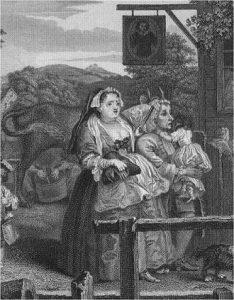
And he does address what the Augustans called the comedy of manners. But ‘comic’ in our modern sense, he isn’t. We’ll look in vain for the exuberance or geniality of spirit with which the comic muse should be associated –- that spirit that encourages us to laugh freely and that enlarges our sense of the possibilities of life. Hogarth, on the contrary, is always intellectual, moral, and judicial. As he himself put it, comedy should tackle ‘subjects that will both entertain and improve the mind, [and] … be of the greatest public utility.’ In short, Hogarth allows us only ‘responsible’ laughter -– a laughter, such as it is, that is directed against others’ folly, never a laughter that is shared with others.
Then, too, I worry about Hogarth’s relationship to London. Of course, his interest in the incidents of street life and in real topographies was as innovative in English art as were his ‘progresses’. He claimed to study walls for their graffiti and signboards for their devices. He would sketch people and places wherever he went –- on his thumbnail, if paper was lacking. Hazlitt knew no artist ‘who had a less pastoral imagination than Hogarth. He delights in the thick of St Giles’s or St James’s. His pictures breathe a certain close, greasy, tavern air’.
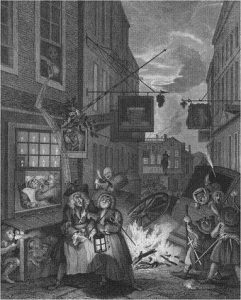
And yet the truth is that his London is never allowed to stand for itself. Instead, it’s compulsively allegorised. Beer Street and Gin Lane (1751) were recognisably set in or near St Martin’s-in-the-Fields and St Giles’s. His Four times of day (1738) were located in Covent Garden, Soho, Sadler’s Wells, and Charing Cross respectively. But in each print it was the didactic point that predominated and was emblematically underscored. In Night, for example, we may believe that we are looking down an alley past the (real) Rummer tavern towards Charles I’s (real) statue in Charing Cross. The barber’s shop and the bagnios advertised on the signboards did exist there, just as the print shows. Even so, Hogarth was not recording London as a later generation might record it. He took great liberties with the topography, subordinating it to the allegorical loading of a much older tradition. In Night, the figure of the drunken magistrate De Veil stood for Pluto, and the woman ejected from her chariot for Proserpina. Every space in the engraving was formally calculated and balanced; and its every visual moment needed deciphering.
In all this, his attitudes to London and its inhabitants were akin to those of the canonical Augustan writers. He shared that bleak vision of the alienated metropolis that stretched from Pope all the way to Blake and Wordsworth. This was either a vision in which, as in Gin Lane, every face was written with marks of weakness, marks of woe; or else it was a vision which was concerned only with his protagonists’ folly, corruption, and vice, and that required them to come to sticky ends. He conveyed no greater joy in the city and its people than most of the Augustan to Romantic poets did.

In this sense Hogarth’s London, like the poets’ London, was, in Jenny Uglow’s phrase, a London of the mind;[1] and its heavy intellectual loading killed the possibility either of a directly pleasurable experience of London, or of pride in it, or of its genial celebration. He might study graffiti or signboards ‘with delight’, as he said, but chiefly because that study offered that ‘pleasing labour of the mind to unfold mystery allegory and riddles’.[2]
The result is that, for me at least, it’s difficult to warm to or like his dark art. Of course, the paintings, in colour, are cheerier than the black-and-white prints he chiefly lived off. Yet apart from his unfinished painting of the smiling flower-girl, or the emblematic moral figures against which he contrasts his protagonists’ folly –- the pregnant girl who stays faithful to the Rake, for example –- there is next to no warmth or generosity in his work. Even his humour was cruel. Nichols tells us that Hogarth once saw a man’s head split open by a quart pot in a tavern fight: ‘The blood running down the man’s face, together with the agony of the wound, which had distorted his features into a most hideous grin, presented Hogarth … with too laughable a subject to be overlooked. He drew out his pencil, and produced on the spot one of the most ludicrous figures that ever was seen.’[3]
Not for nothing did Baudelaire much later write of Hogarth’s ‘cold, astringent, and funereal ingredient’ and see in him ‘the death and burial of the comic spirit’ –- thanks to ‘that indefinable breath of the sinister, the violent, and the ruthless which characterises almost every product of the land of spleen.’[4] This rings more true to modern tastes than do the repeated claims that Hogarth was comic.
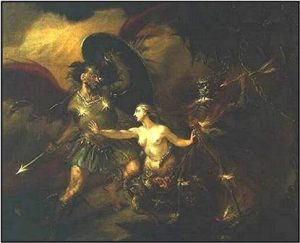
Let’s now get to the point. What did later satirical artists inherit from Hogarth? A great deal of course, but not, I want to argue, this darkness of spirit, this joylessness. Hogarth’s joylessness they rejected.In all sorts of ways his legacy in English satirical art is undoubted. Just as Hogarth’s Satan, Sin, and Death echoes directly into Gillray’s satire on Pitt sixty years later, Sin, Death and the Devil.
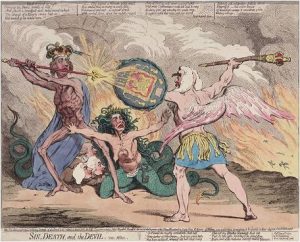
So the Prince of Wales’s post-coital posture in Gillray’s satire on his illicit marriage, The morning after Marriage –- or –- a Scene on the Continent (1788), replays the bored wife’s posture in Marriage a la Mode. Nor were Hogarth’s great debauchery scenes ever forgotten.

Midnight Modern Conversation, the Election Entertainment, the tavern scene in Rake’s Progress -– all of these echo down into the explosion of debauchery prints which filled the printshops around 1800.
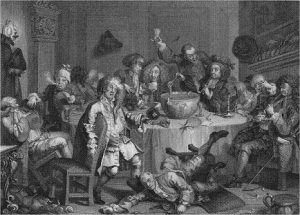
Go to Rowlandson’s wonderful boozing scenes from the 1800s in particular, and we find them citing and parodying Midnight Modern Conversation overtly.
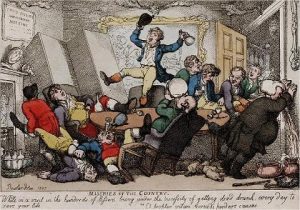
Time and again, moreover, Hogarth’s street scenes and spatial conventions are hi-jacked by the ensuing generations. Here Isaac Cruikshank in 1799, for instance, cites Hogarth’s Enraged Musician
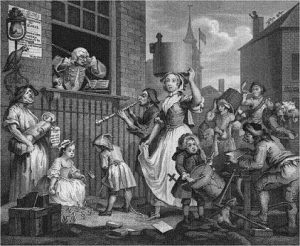
in his satire on the Lord’s Day Observance zealot Lord Belmont,

–- here deploring the noise made by Sunday street-sellers outside his window, even as he ignores the equal noise made by the fashionable rout in the house opposite. None of these legacies is surprising in an era swept by what someone in 1781 called ‘Hogarthomania’. In the 1780s and 90s Hogarth’s plates were much republished, and I have no doubt that every satirical engraver of that period owned and knew them inside out.
But that’s the easy part of our argument. It’s the discontinuities that I’m most interested in, because they give the lie to the common notion that Hogarth was the father of English comic and satirical art. The truth is that in and after the 1780s the purposes, meanings, and tone of visual satire changed utterly, taking us into a graphic world whose impulses he would barely have recognised. The indices of change can be quickly listed.
First, Hogarth’s death sees the effective demise for a century of his modern moral ‘progress’, often regarded as his greatest invention. After his death nobody again attempted one until George Cruikshank did in his dreary teetotal series The Bottle and The Drunkard’s daughter in 1848 and 1849. You won’t once find a Hogarthian progress in Gillray, or the Cruikshanks, or Rowlandson. There were ‘strip’ caricatures from Woodward, yes, but narrative ‘progresses’ never again until the sober-minded mid-19th-century.
Secondly, graphic satire became increasingly personalised, rejecting earlier eighteenth-century rules that it should never name names. When Hogarth sub-titled his Midnight modern conversation ‘Think not to find one meant resemblance there / We lash the vices but the persons spare’,[5] he was deferring to the polite Addisonian ruling that the satirist should go for the type of person rather than the named individual. Well by the 1780s this reticence was obsolescent. The boundaries between the public and the private spheres became hazy, as any number of sexually promiscuous adulterers or adultresses like Lady Dorothy Worsley, not to mention the Prince of Wales, were to learn to their cost.
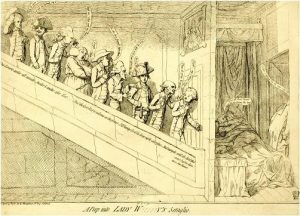
The third thing to disappear is Hogarth’s theatricality. ‘My picture is my stage,’ he had written, ‘and men and women my players, who by means of certain actions and gestures, are to exhibit a dumb show.’[6] All innovative and important, we may feel. But this principle cost Hogarth a good deal. Along with his refusal to resort to caricature, its outcome was a series of static tableaux which quite lacked the dynamism achieved by the later generation. Here is an example from Gillray, by way of contrast, of what lay ahead.

What displaced Hogarth’s frozen tableaux was a far greater fluidity and informality of expression -– as the quickly etched line displaced the painstakingly engraved line, and as the exaggerations of caricature displaced Hogarth’s pseudo-realism. No doubt the spread of water-colouring in the 1790s helped enhance the energy too; but Hogarth could never have imagined, let alone achieved, the manically exaggerated and dynamic lines of Gillray in this image, or of Rowlandson in this watercolour drawing of 1805.
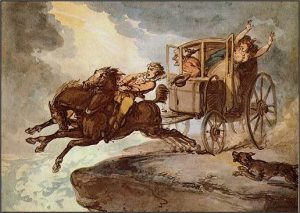
The sheer energy of images like these reflected a very different take on life from that of the Augustans. These later images celebrated rather than criticised life. ‘What a picture of life was there!’ George Cruikshank was to exclaim of a grimy tavern he visited: ‘It was all life!’ Here, he said, he met a mixture ‘of the sublime and the ridiculous, where extremes met; where the highest and the lowest united in harmonious fellowship. …’[7] ‘Life’ was the business in hand, and life in this coming tradition didn’t need to be judged.
So, finally, as a summation of these changes, we witness in later Georgian and Regency satires a wholesale retreat from Hogarth’s moral didacticism. What displaced it was a taste for celebrating London in a more relaxed and expansive relationship to the streets than any poet or artist of Hogarth’s generation could have attempted -– a pleasure in urban bustle and urban types for their own sake. So if we move from Gin Lane to Ramberg’s Humours of St Giles, for example,

we find the representation of the urban scene quite transformed. Here pick-pocketing and practical joking are the print’s cheerful business. The boys play at dice; trades and occupations are deftly identified; in a Hogarthian touch the lampman to the right drips oil onto the roast joint carried by the cook on his head; and the central girl is drunk and (in Ramberg’s original before Rowlandson re-engraved it) bare-breasted. The dense reference and moral content of Gin Lane are discarded in favour of a scene of cheerful, work-a-day bustle. This is an image without pretensions; it is offered as an amused reflection of an exaggerated reality. Prints about life in London enter a different representational world around this point, and they stay there for another fifty or so years.
The shift had many causes. The main cause was the expansion of print culture generally, thanks to the growing market and its multiplying expectations. With the spread of income, political sophistication, and literacy, the market broadened steadily. By the 1800s print-purchasers were to include West End sophisticates, women buying fashion satires on their own account, lower professionals, upper shopkeepers, and even skilled craftsmen to whom more and more income was accruing. In this climate the demand for political commentaries never abated; but it is significant that what the British Museum catalogued as ‘social satires’ on manners and scandal made up around a half of all print output. They also came to be sold in new ways. Whereas Hogarth had sold on his own account and by soliciting subscriptions, Gillray, Rowlandson, Cruikshank and others sold through the multiplying printshops -– Humphrey’s, Holland’s, Fores’s, Ackermann’s -– that sprang up in the 1780s and 1790s to cater to an expanding middle class as well as aristocratic custom. By 1800, William Blake could note approvingly that book- and print-sellers were as numerous as butchers. The result was an astonishing acceleration in print output. Thus the British Museum catalogues 17,391 print titles published from earliest times to 1832. 12,543 of these were published after 1771 -– while nearly two-thirds of those 12,543 were issued after 1800; and the purposes, varieties, and quality of those later prints became infinitely more diverse than those of their predecessors.
The outcome was a new kind of image. Less haunted by classical analogies than the taste-makers of earlier generations had been, these new customers (image-starved as they were) wanted not to be preached at, but to be fed representations of their own lives and environs. As a result very many of the prints we nowadays tend to decode as satirical are only lightly so: their main business was humour. They aimed at purchasers who wanted to, and sometimes did, feel good about life. They revealed an interest in real rather than symbolic topographies, in quotidian rather than emblematic incident, in the passing sensations which constituted the stuff of conversation –- and all this with scant regard to moral meanings. They allowed themselves to be amused and titillated by London as Hogarth never could be. Striking in their images, consequently, is a flight from didacticism and –- at last –- a deepening engagement with what we today regard as comic.
We can see this in all sorts of contexts. Take the two vices that Hogarth had once been so upset by – prostitution and drunkenness. As Hogarth never could, on these vices our later generation of printmakers generally refused to pass judgement. In Hogarth’s Harlot’s progress (1732), the narrative that brought Moll Hackabout to her miserable end left purchasers in no doubt what to think about the prostitute’s choices. But later eighteenth-century prints on the subject refused to direct meanings in the same way. The classic case is Gillray’s extraordinary Whore’s last shift of 1779.
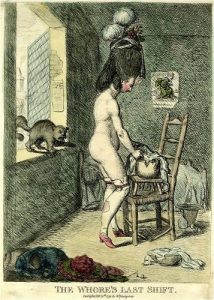
In her garret, the naked whore concludes her night’s business by washing her last shift in her chamberpot (the pun on ‘shift’), the incongruous finery of her hairpiece belied by her tattered stockings, both indicating that she had come down in the world. Hogarthian symbols: the cat arches its back in lust and the pot is cracked. The print might intend no more than a conventional if eroticised comment on the contrast between the outward presentation of the self and the corrupted inner reality, echoing Swift’s satire to that effect, Beautiful young nymph going to bed. But is it contemptuous of the poor woman, or does it seek to disclose the poignancy of her plight? The answer –- as never in Hogarth –- is left to the viewer.
Or, in a different spirit, take Rowlandson’s Cattle not insurable of 1809.
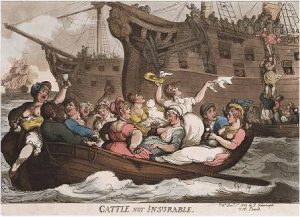
It shows a wonderful boatload of whores being ferried to service the sailors on the ships berthed at Portsmouth, and in this print the girls stand for a part of male life’s rich feast, and, hopefully, for the girls’ own exuberant happiness also. We are nowadays conditioned to assume that eighteenth-century prostitutes were exploited and miserable. But the tone of the satires obliges us to ask whether the girls themselves would have thought of themselves in this way, in an era when life expectations were modest and the stigma attached to prostitution weaker than they became. Rowlandson and other artists have no hesitation in suggesting that countless whores might actually have been happy.
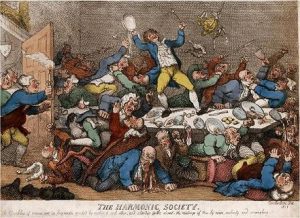
As for male debauchery, Rowlandson’s exuberance on the subject speaks for itself. He tips his hat to Midnight modern conversation; but again the comic vitality of the line and the caricature simply get in the way of moral judgement. Or again, one of Gillray’s greatest prints is his depiction of the whig Union Club in their cups in Pall Mall, in 1801.
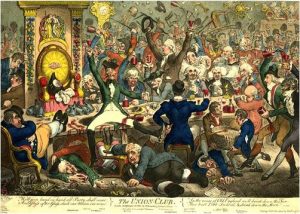
We could read this as a satire on the Whig grandees and the Prince of Wales. But I think the print is too amused by its own excess to be read simply as a satire. Gillray seems half in love with what he mocks. The print may chastise the prince and the whigs for their indulgence, but it doesn’t invite us into full-blown disgust, as Hogarth’s debauchery prints were meant to. Here again the print unavoidably comic. The same is true of George Cruikshank’s several replays of Gillray’s scene, in his Dinner of the Four-in-Hand Club for example.
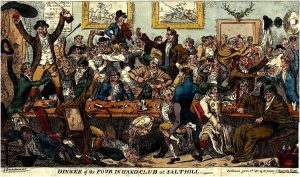
Do prints like these pass judgement? I don’t think they do, or if they do, judgement is only the thinnest of alibis for the celebratory humour with which these behaviours are depicted. Again, there is no mystery why this should be so. Key parts of the market were precisely the kinds of well-heeled playboys, rakes, and aristocrats whose bad manners these kinds of image commemorate; and if my reading is correct, they bought prints like these not to chastise themselves, but as comic mementos of their own excess, just as young clubbers today might cherish digital images of their own intoxication.
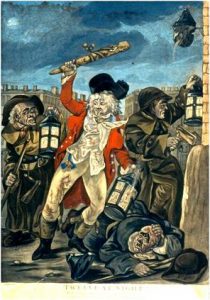
Let’s return finally to the changing representation of London -– because here too we meet that same non-judgemental, upbeat jollity and delight in the city’s pleasures and vexations. And this delight, it seems to me, reflecting public taste as it did, tells us far more about the prevailing attitudes and preoccupations of everyday people than canonical literature or art can ever hope to do. I’m talking about people who bought prints in order to celebrate their city, or to indulge a sardonic amusement about and even pride in its many inconveniences. As Charles Lamb wrote to Wordsworth in 1801: ‘I often shed tears in the motley Strand from fulness of joy at so much life’[8] -– then listing how and where that life manifested itself, and adding that he would choose London’s vitality above all the sheep of the Lake District.

And so, in print after print by Woodward, Rowlandson, or Cruikshank, these and like wonders are paraded. Fat citizens gaze in wonder at the new gas lights in Pall Mall; or rough plebeians have jolly mishaps on the frozen Thames.
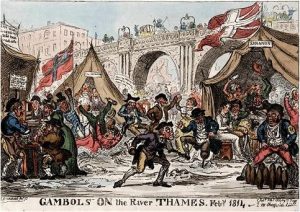
And the pioneer in this new art was that uniquely innovative but careless comic genius Thomas Rowlandson.
Now, in modern histories of graphic satire Rowlandson has always been overshadowed by Gillray -– and there’s no doubt that his satiric if not artistic range was narrower. He was indifferent to politics, for example; and there’s a sameness about his grotesque old men, fat older women, and luscious young women, and a high quantity of repetitious hack-work. On the other hand not only was he the most prolific of late eighteenth- and early nineteenth-century artists; he was also the most brilliant and unequalled of draughtsmen and, at his best, also the funniest.
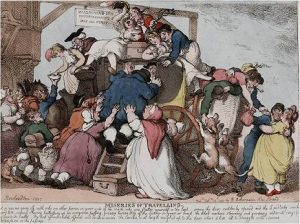
Of prints like his Miseries of travelling, with its pyramidal construction and its dynamic figure-caricature, one might well exclaim with Cruikshank later, ‘What a picture of life is there! It is all life!’[9] Similarly, in his ‘Miseries’ series around 1807-10 he unleashed his comic delight in chaos as well as his typically sardonic amusement at the comic vexations of London living.
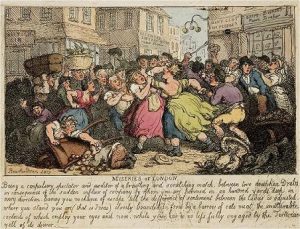
Two prints stand out here. This one, first, depicts his own entanglement in a ‘brawling and scratching match’ of two drunken drabs – in St Giles’s no doubt: there he is on the right. And even more wonderfully, this depiction of one of those traffic jams that do so hold one up on one’s way to dinner:
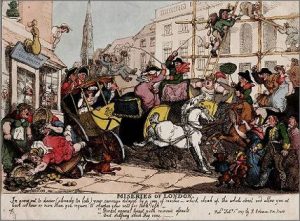
–- a splendidly tumultuous composition, this, one of his greatest.
Let’s be clear that the legacy of images like these for graphic art in the first half of the nineteenth century was far greater than Hogarth’s legacy. They fed into the work of George Cruikshank, most notably. Cruikshank was to replicate that street fight in one of his illustrations in Sketches by Boz, for example. He also replayed Rowlandson’s traffic jam in later prints like his Grievances of London in 1835.
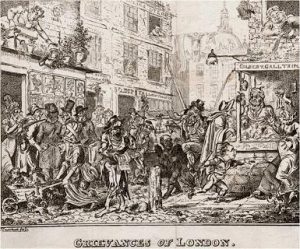
–- though his most notable tribute to the archetypal Rowlandsonian traffic jam is his Piccadilly Nuisance of 1818:

But surely the most important legacy of the Rowlandsonian and hence Cruikshankian vision is found in that greatest of all verbal caricaturists, Dickens. The congruence between Dickens’s vision in this incarnation and that of the engravers of his boyhood days is recurrently apparent. Dickens was born into the same boisterous middling cultures as the engravers were, after all. He, too, loved penny theatres and low street life, and his cast of humour was as boisterous, ironic, and sentimental as theirs. No surprise, then, that Cruikshank and Dickens in 1836 began their collaboration in Dickens’s Sketches by Boz, or that at that point, it measured Cruikshank’s stature that he wasn’t called ‘Dickensian’; it was Dickens who was dubbed ‘the CRUIKSHANK of writers’. And look finally at this Rowlandson caricature, of A midwife going to a labour (1811). If this isn’t the prototype of Dickens’s Sarah Gamp, what is?
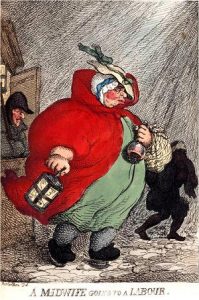
Endnotes
[1] J. Uglow, Hogarth: A Life and a World, 1997, Faber & Faber, London, pp.299, 302-3. Cited in Gatrell, City of Laughter: sex and satire in eighteenth-century London, London, 2007, p. 40.
[2] Uglow, p. 611.
[3] John Nichols and George Steevens, The Genuine Works of William Hogarth (3 vols) (1808-1817), vol. III pp. 13-14. Cited in J. Uglow, Hogarth: A Life and a World, 2nd edition 1999, Faber & Faber, London, p. 54.
[4] C. Baudelaire, ‘Some Foreign Caricturists’ (1859) in P. E. Charvet (ed.), Baudelaire: Selected Writings on Art and Literature, London, 1992.
[5] R. Paulson, Hogarth’s Graphic Works, 1989 (3rd revised edition), London, The Print Room, p. 84. Cited in Gatrell, p. 173
[6] W. Hogarth, ‘Autobiographical Notes’, in The Analysis of Beauty, with the Rejected Passages from the Manuscript Drafts and Autobiographical Notes, ed. Joseph Burke, Oxford, 1955, p. 209.
[7] Cited in Gatrell, p. 551.
[8] E. W. Marrs (ed.), The Letters of Charles and Mary Ann Lamb (3 vols) Ithaca NY, 1975, vol. I p. 267. Cited in Gatrell p. 33.
[9] Cited by Gatrell, p. 551.
To Cite This Article:
Vic Gatrell, ‘London and the Pleasure Principle: Tate Britain Hogarth Exhibition, Symposium 9 February 2007’. Literary London: Interdisciplinary Studies in the Representation of London, Volume 6 Number 1 (March 2008). Online at http://www.literarylondon.org/london-journal/march2008/gatrell.html. Accessed on [date of access]
